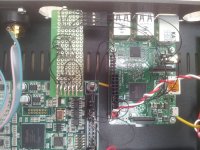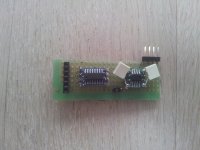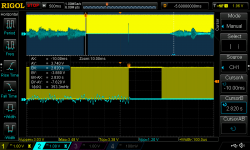A cheap RS232 to TTL serial converter with isolation barrier. MAX3223 + ISO7221M used, because that's what I had at my disposal. But any similar combo will do. Can be powered from 5V or 3.3V dam1021 rails.
Yeah, it's ugly, soldering wires to header pins can be tiresome, but it works!
Yeah, it's ugly, soldering wires to header pins can be tiresome, but it works!
Attachments
Nice, but what good does your isolator do since you have common GND between the DAM and the RPi anyway (because of the I2S lines)?
I2S traces on dam1021 go through ic isolators too (some Silicon Labs chips).
I was having a problem getting RPi B+ I2S outputs to work using Volumio 1.55 software. There was no signal present on the GPIO pins no matter what drivers I used.
The problem was solved by updating RPi firmware. The procedure below is based on these documents:
https://volumio.org/volumio-raspberry-pi-b-plus/
https://github.com/Hexxeh/rpi-update
Firmware update procedure:
1) Make sure the RPi is connected to a network with internet access
2) Log on to RPi using SSH over the network, or use directly connected keyboard and monitor.
3) Check the date on your RPi using the 'date' command. It should be at least reasonably close to the current day. If it is too far behind or ahead, the Github SSL certificates may be rejected during the update step.
If necessary, use the date command to set the correct date and time, or set up ntp as described here: https://github.com/Hexxeh/rpi-update#troubleshooting
4) Run these commands to update the firmware:
Code:sudo apt-get update sudo apt-get install binutils sudo rpi-update
The rpi-update comand can take awhile to finish and may appear to hang for several minutes. Just let it finish. In my case rpi-update took about 15 minutes to complete.
5) Reboot the RPi.
6) In Volumio web GUI set the I2S output type to generic.
Problem solved!
do u get signal lock loss when u change track and as a result a few seconds of the music is lost?
Yes, with the accompanying KABOOM every time when DAM acquires the lock. It even happens when skipping to a different location within the same track. It is very annoying.do u get signal lock loss when u change track and as a result a few seconds of the music is lost?
I have not checked what actually happens on the I2S lines in this case, but probably it is the same problem as seen with Amanero USB interface. DAM looses lock if the bit clock signal stops even for a few microseconds.
The real fix for it IMHO should be in DAM firmware (as no other DAC that I have behaves this way). As a workaround, it may be possible to fudge the RPi I2S drivers to never stop the bit clock signal even when there is no audio playing. A similar hack helps with Amanero.
.......The real fix for it IMHO should be in DAM firmware (as no other DAC that I have behaves this way). As a workaround, it may be possible to fudge the RPi I2S drivers to never stop the bit clock signal even when there is no audio playing. A similar hack helps with Amanero.
Sort of the digital equivalent of a 'make-before-break' switch.....
Hi there,
I would like to give you a note that the dam1021 can be nicely integrated with mopidy right now [1]. You can control volume level and mute/unmute signals from whatever client supports this (and that means a large pool of mpd-compatible clients). Default configuration has been prepared for RPi. But in practise any Linux/MacOSX would benefit from this extension.
A nice feature is that you can redefine volume level range as seen by mopidy, so that you could achieve a finer control over levels you feel comfortably with the most. This might be useful if you use mobile mpd clients.
[1] https://github.com/fortaa/mopidy-dam1021
I would like to give you a note that the dam1021 can be nicely integrated with mopidy right now [1]. You can control volume level and mute/unmute signals from whatever client supports this (and that means a large pool of mpd-compatible clients). Default configuration has been prepared for RPi. But in practise any Linux/MacOSX would benefit from this extension.
A nice feature is that you can redefine volume level range as seen by mopidy, so that you could achieve a finer control over levels you feel comfortably with the most. This might be useful if you use mobile mpd clients.
[1] https://github.com/fortaa/mopidy-dam1021
I had no problems with the RPI B and the Soekris in combination with piCorePlayer, and now I am playing with the Soekris and Vortexbox and the Amanero, all I²S combinations.
Problems I had with the distance from the cables, they must be as short as possible.
Personal I don’t like Volumio and some other combinations, they are in many options not the stable solutions/combinations.
For the RPI (Arm7 boards) the most and reliable is piCorePlayer.
I used also the combination with a Cubieboard, and tried many others, and for the x86 (intel) the most stable is for me the Vortexbox.
Now I have also a combination with the Odroid U3 and the Ubuntu software, they all are working stable with the Amanero.
With the Vortexbox/Amanero and the Soekris Dam it is the most musical and dynamic solution.
Problems I had with the distance from the cables, they must be as short as possible.
Personal I don’t like Volumio and some other combinations, they are in many options not the stable solutions/combinations.
For the RPI (Arm7 boards) the most and reliable is piCorePlayer.
I used also the combination with a Cubieboard, and tried many others, and for the x86 (intel) the most stable is for me the Vortexbox.
Now I have also a combination with the Odroid U3 and the Ubuntu software, they all are working stable with the Amanero.
With the Vortexbox/Amanero and the Soekris Dam it is the most musical and dynamic solution.
Yes, with the accompanying KABOOM every time when DAM acquires the lock. It even happens when skipping to a different location within the same track. It is very annoying.
I have not checked what actually happens on the I2S lines in this case, but probably it is the same problem as seen with Amanero USB interface. DAM looses lock if the bit clock signal stops even for a few microseconds.
The real fix for it IMHO should be in DAM firmware (as no other DAC that I have behaves this way). As a workaround, it may be possible to fudge the RPi I2S drivers to never stop the bit clock signal even when there is no audio playing. A similar hack helps with Amanero.
The interesting thing is that picoreplayer does not have this problem. On my picoreplayer does not lose lock. But some how my picoreplayer at times will just play the first track and stop. I cant figure out what's wrong
It could be a problem with the length of the wires, the I2S line DAC from RPI off a friend who was trying, had the same problems.
After a new and shorter wire length the problem was over.
The problem was with a Raspberry and a combination with a ESS9023 DAC.
Now it’s sounding clear and stable.
After a new and shorter wire length the problem was over.
The problem was with a Raspberry and a combination with a ESS9023 DAC.
Now it’s sounding clear and stable.
I did a small investigation about DAM loosing lock with Volumio RPi source when changing tracks or skipping to a different location within the same track.
This is with unmodified DAM hardware, using firmware v0.9 and EQHQ_v2 filters.
It turn out to be the word clock signal (LRCLK/FSCLK) that stops for about 20 ms. This is different from Amanero, where bitclock is interrupted. The result, however, is the same. It causes DAM to loose lock for 2.8 seconds with all the accompanying ugliness of DAM relocking. There is that high frequency 4Vpp destroyer pulse in the middle of locking period, and the ramping up of sound after the pause also happens with a very ugly blurp.
As reported by several people here, it does not happen with piCorePlayer because it does not stop any of the clock signals when skipping tracks.
piCorePlayer uses sndrpihifiberry I2S driver for the generic setting, while Volumio uses sndrpirpidac driver. Configuring Volumio to use sndrpihifiberry driver does not change the relocking behaviour, so the problem does not seem to be with I2S drivers. Perhaps it is caused by some mpd behavior in Volumio.
In summary, piCorePlayer works well if you have Logitech Media Server in the environment. Volumio, on the other hand, is pretty useless in combination with DAM.
This is with unmodified DAM hardware, using firmware v0.9 and EQHQ_v2 filters.
It turn out to be the word clock signal (LRCLK/FSCLK) that stops for about 20 ms. This is different from Amanero, where bitclock is interrupted. The result, however, is the same. It causes DAM to loose lock for 2.8 seconds with all the accompanying ugliness of DAM relocking. There is that high frequency 4Vpp destroyer pulse in the middle of locking period, and the ramping up of sound after the pause also happens with a very ugly blurp.
As reported by several people here, it does not happen with piCorePlayer because it does not stop any of the clock signals when skipping tracks.
piCorePlayer uses sndrpihifiberry I2S driver for the generic setting, while Volumio uses sndrpirpidac driver. Configuring Volumio to use sndrpihifiberry driver does not change the relocking behaviour, so the problem does not seem to be with I2S drivers. Perhaps it is caused by some mpd behavior in Volumio.
In summary, piCorePlayer works well if you have Logitech Media Server in the environment. Volumio, on the other hand, is pretty useless in combination with DAM.
Attachments
I have the same setup, Dam firmware 0.9 and the Amanero, but don’t use MPD anymore because I can use Vortexbox and the DSD2PCM now, I will try tomorrow how it works with MPD and the Ubuntu setup that I have installed.
Maybe I can find where the problems are, Volumio is not my target.
Maybe I can find where the problems are, Volumio is not my target.
sketchy diyaudio 101:
Got external clock synced with r2r
BBB is running volumio with Botic kernal
with master_clk option 9
BBB uses external master clock for 44k1 and on board for 48k
two questions:
1. have you noticed any difference in sq with bbb external clock on when compared to pure dam1021 reclocking/buffering?
2. why are xlr ground pins connected to dac ground instead of chassis ground?
two questions:
1. have you noticed any difference in sq with bbb external clock on when compared to pure dam1021 reclocking/buffering?
2. why are xlr ground pins connected to dac ground instead of chassis ground?
1 BBB can not output 44k1 without external clock. currently I use external clock for 44k1 and on board 48k so that has to wait when I test with exteranl clock for 48k vs on board clock 48k.
2 I tried to float DAM ground from earth groud.
2 I tried to float DAM ground from earth groud.
So positive and negative of balanced signal should suffice, shouldn't they?
So positive and negative of balanced signal should suffice, shouldn't they?
Sound System Interconnection
An externally hosted image should be here but it was not working when we last tested it.
An externally hosted image should be here but it was not working when we last tested it.
In my case, signal ground is not connected to earth ground.
Last edited:
Hi mcluzun, have you tried the master clock out from the dam into the BBB? Thanks in advance...
Enviado desde mi LG-E970 mediante Tapatalk
I'm trying to get it work.
I've connected DAM master clk out to BBB master clk in, and clksel respectfully.
So fat I've got 48/96k locking (constant light on on DAM). But the music is some how distorted.
And 44.1k is not locking at all.
I had to play around a little to tell.
- Home
- Source & Line
- Digital Line Level
- Linux servers and Soekris DAM1021



